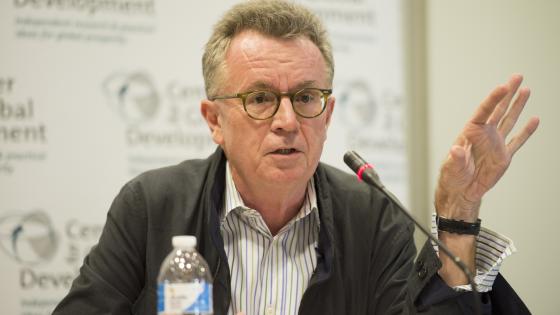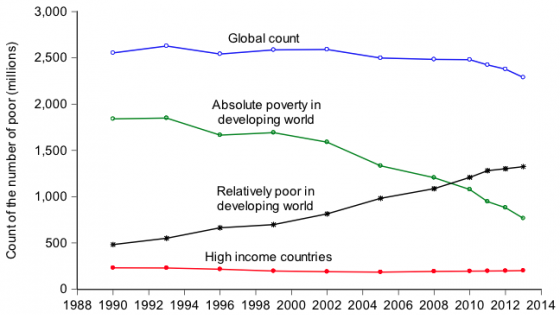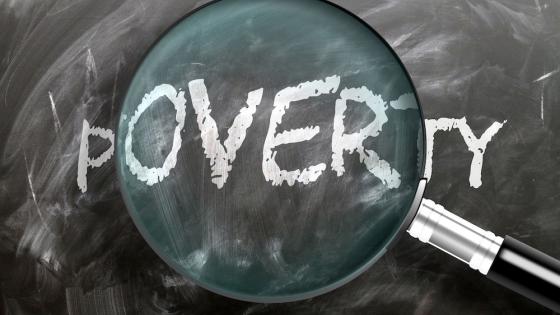The year 2022 ended on a sad note with the passing of Martin Ravallion, who worked for a quarter of a century at the World Bank and then at Georgetown University. Ravallion was also a non-resident fellow at the Center for Global Development (CGD), where he engaged actively in policy debates.
Ravallion is most famous for his extensive work on the measurement of poverty and inequality. If you’ve ever heard poverty characterised as living on $1 a day (or $1.08 a day, or – later – $1.25 a day), that comes from his work (with collaborators; Ravallion et al. 2009). As economist Branko Milanovic wrote, without the data that Ravallion was “crucial” to collecting and analysing, “we would not know today what is the state of the world in such important aspects as poverty and inequality”. Beyond measurement of poverty, Ravallion researched programmes and policies that sought to reduce poverty.
Journalists Sanne Blauw and Maite Vermeulen provided an accessible portrait of Ravallion and his work in De Correspondent back in 2016, calling him “the greatest anti-poverty crusader you’ve never heard of”. They close with these words: “How many people, precisely, has Ravallion rescued from poverty? Even his advanced statistical methods can’t answer that. But though it can’t be measured, not a single colleague is in doubt: without Ravallion’s work, there would be far more poverty in the world.”
Ravallion was influential and prolific. He has more than 370 publications that have been cited at least ten times. His articles extend from a 1979 theoretical note in Urban Studies on why wages may vary within an urban area (Ravallion 1979) to a full nine articles published last year in 2022 (some as working papers and some as journal articles), mostly on his primary topics of expertise – poverty and inequality. But Ravallion’s work extended far beyond those areas, including articles on education, multidimensional development indices, health and more.
If you’re just becoming aware of Ravallion’s work, here’s a micro-summary of each of his 15 most cited (per year since publication) articles. In the references, I include links to the published articles as well as open-access versions, where I found them.
How can we measure poverty (and the effects of anti-poverty programmes)?
How do you compare poverty levels over time? How do you compare poverty across places? How can you tell if poverty has fallen after the introduction of some policy? Ravallion literally wrote the book on it: Poverty Comparisons. “Household surveys are the single most important source of data for making poverty comparisons” (Ravallion 1994).
That isn’t enough on poverty for you? In 2016, Ravallion published a 700+ page book not only on measuring poverty but also on the history of how people have thought about poverty and the range of policies used to tackle poverty (Ravallion 2016). David McKenzie wrote a useful review of this on the Development Impact blog.
Poorer countries tend to have lower poverty lines – in other words, a person has to be poorer in absolute terms to be classified as poor. The older ‘$1 a day’ classification came from the national poverty lines of the poorest countries. Updated data from 2005 bring that to $1.25 a day as an indicator of poverty (Ravallion et al. 2009).
“Despite the claims of advocates, no single method [for evaluating anti-poverty programmes] dominates; rigorous, policy-relevant evaluations should be open-minded about methodology, adapting to the problem, setting and data constraints… Good evaluations draw pragmatically from the full range of tools available.” (Ravallion 2007).
What is the link between economic growth, poverty, and inequality?
New data on national poverty lines and on prices show that as of 2005, there were more households in poverty (25%) than previous estimates had suggested, but that progress over time was still positive (Chen and Ravallion 2010).
What is the relationship between economic growth, poverty levels, and inequality? It depends! While there isn’t a consistent correlation between economic growth and inequality, there are many country examples of inequality going in either direction as economies grow. “While good policymaking for fighting poverty must obviously be concerned with the aggregate impacts on the poor, it cannot ignore the diversity of impacts underlying the averages, and it is here that good micro empirical work can help” (Ravallion 2001).
How much does economic growth benefit the poor? Using a new approach to measure this suggests that the way to look at this is to look at growth specifically for the poor. In China in the 1990s, growth for the poorest was much slower than growth overall (Ravallion and Chen 2003).
Across 67 “developing and transitional economies” during the 1980s and early 1990s, economic growth and inequality were generally uncorrelated. “Overall, there was a small decrease in absolute poverty” (Ravallion and Chen 1997).
How is poverty changing over time?
“Over the two decades following [China’s] initiation of pro-market reforms in 1978 … China has made huge overall progress against poverty”, but inequality has risen and “economy-wide policies [like trade reforms] have had a mixed record” (Ravallion and Chen 2007).
“Over 1993–2002, the count of the ‘$1 a day’ poor fell by 150 million in rural areas but rose by 50 million in urban areas… Latin America has the most urbanized poverty problem, East Asia has the least” (Ravallion et al. 2007).
What does it mean to be middle class? If you define it as people who are above the median poverty line of low- and middle-income countries but still poor by rich-country standards, then between 1990 and 2005, 1.2 billion people joined “the developing world’s middle class. Four-fifths came from Asia, and half from China” (Ravallion 2010).
“By the frugal $1 a day standard there were 1.1 billion poor people in 2001—almost 400 million fewer than 20 years earlier”. A lot of that drop in poverty was from China in the early 1980s. “At the same time the number of people in the world living on less than $2 a day rose, so that there has been a marked bunching up of people living between $1 and $2 a day. Sub-Saharan Africa has become the region with the highest incidence of extreme poverty and the greatest depth of poverty” (Chen and Ravallion 2004).
How defensible are development indices?
International organisations produce lots of “mashup indices of development”, which seek to boil down lots of indicators into a single measure – think the Human Development Index, the Doing Business Index, the World Bank’s Country Policy and Institutional Assessments, among many others. But it is often unclear what indicators should be included in the indices, how to weight the indicators and how sensitive the indices are to small changes in indicators. “A composite index is not essential for many of the purposes of evidence-based development policymaking” (Ravallion 2012).
People reasonably argue that the ability to buy stuff isn’t the only thing that matters: as a result, they develop ‘multidimensional indices of poverty’, which combines measures of lots of things that matter. “We can all agree that reducing child mortality is a hugely important development goal, but how can one contend … that avoiding the death of a child is equivalent to alleviating the combined deprivations of having a dirt floor, cooking with wood, and not having a radio, TV, telephone, bike or car? … The specific country and policy context should determine what tradeoff is considered appropriate” (Ravallion 2011).
And wait, here’s a little something on education
Providing food rations to parents who kept their kids in school in Bangladesh “increased schooling by far more than it reduced child labor” (Ravallion and Wodon 2000).
Conclusion
To conclude, I’ll share one of Ravallion’s more recent papers – one that’s significantly affected my own thinking. The finding is in the title: “Most of Africa's nutritionally deprived women and children are not found in poor households” (Brown et al. 2019).
Specifically, using survey data from 30 African countries, the researchers find that about “three-quarters of underweight women and undernourished children are not found in the poorest 20% of households, and around half are not found in the poorest 40%”. So if anti-poverty programmes target the poorest households (which they often do), they may be missing many of the poorest women and children.
This paper, along with the 15 above, and literally hundreds more, will continue to shape poverty measurement and anti-poverty policy for longer than any of us will be working. My gratitude – and that of my colleagues at CGD and many, many others in the development community – goes out to Professor Ravallion. Rest in peace.
Authors’ note: Thanks to Amanda Glassman, Amina Mendez Acosta and Justin Sandefur for improving this post. I also recommend this remembrance of Martin Ravallion from two World Bank researchers, David McKenzie and Berk Özler. This column originally appeared on the Center for Global Development blog.
References
Brown, C, M Ravallion and D van de Walle (2019), “Most of Africa's Nutritionally Deprived Women and Children are Not Found in Poor Households”, Review of Economics and Statistics 101(4): 631-44 (open access).
Chen, S and M Ravallion (2004), “How Have the World's Poorest Fared since the Early 1980s?”, World Bank Research Observer 19(2): 141-69 (open access).
Chen, S and M Ravallion (2010), “The Developing World is Poorer than We Thought, But No Less Successful in the Fight Against Poverty”, Quarterly Journal of Economics 125(4): 1577-1625 (open access).
Ravallion, M (1979), “A Note on Intra-Urban Wage Differentials1”, Urban Studies 16(2): 213-15.
Ravallion, M (1994), Poverty Comparisons, Taylor and Francis.
Ravallion, M (2001), “Growth, Inequality and Poverty: Looking Beyond Averages”, World Development 29(11): 1803-15 (open access).
Ravallion, M (2007), “Evaluating Anti-Poverty Programs”, in T Paul Schultz and John A Strauss (eds), Handbook of Development Economics, Vol. 4, pp. 3787-3846 (open access).
Ravallion, M (2010), “The Developing World's Bulging (but Vulnerable) Middle Class”, World Development 38(4): 445-54 (open access).
Ravallion, M (2011), “On multidimensional indices of poverty”, Journal of Economic Inequality 9(2): 235-48 (open access).
Ravallion, M (2012), “Mashup Indices of Development”, World Bank Research Observer 27(1): 1-32 (open access).
Ravallion, M (2016), The Economics of Poverty: History, Measurement, and Policy, Oxford University Press.
Ravallion, M and S Chen (1997), “What Can New Survey Data Tell Us about Recent Changes in Distribution and Poverty?”, World Bank Economic Review 11(2): 357-82 (open access).
Ravallion, M and S Chen (2003), “Measuring pro-poor growth”, Economics Letters 78(1): 93-99 (open access).
Ravallion, M and S Chen (2007), “China's (uneven) progress against poverty”, Journal of Development Economics 82(1): 1-42 (open access).
Ravallion, M, S Chen and P Sangraula (2007), “New Evidence on the Urbanization of Global Poverty”, Population and Development Review 33(4): 667-701 (open access).
Ravallion, M, S Chen and P Sangraula (2009), “Dollar a Day Revisited”, World Bank Economic Review 23(2): 163-84 (open access).
Ravallion, M, and Q Wodon (2000), “Does Child Labour Displace Schooling? Evidence on Behavioural Responses to an Enrollment Subsidy”, Economic Journal 110(462): 158-75 (open access).



